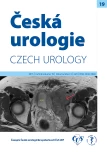A COMPARISON OF CHARACTERISTICS OF SEMINOMAS AND NONSEMINOMAS IN PATIENTS, WHO UNDERWENT RADICAL ORCHIECTOMY FOR TESTICULAR TUMOR
Authors:
Jiří Stejskal 1; Zuzana Donátová 2; Jan Mokriš 1; Novák Jan 1; Martin Foldyna 2; Tomáš Büchler 2; Martin Kupec 2; Jitka Abrahámová 2; Roman Zachoval 1
Authors‘ workplace:
Urologické oddělení, Thomayerova nemocnice, Praha
1; Onkologická klinika 1. LF UK, Thomayerova nemocnice, Praha
2
Published in:
Ces Urol 2015; 19(3): 210-215
Category:
Original Articles
Overview
Characteristics of testicular tumors in a group of 84 patients and a comparison with data form Czech National Cancer Registry and literature.
Aim:
To compare characteristics and treatment results of testicular tumours in our group of patients.
Methods:
Time of follow up, age, duration of symptoms, laterality, clinical stage, treatment modality and its results were evaluated in all patients that underwent radical orchiectomy at our department between 2006 and 2010. Our findings were then compared with information provided in literature
Results:
A total of 87 radical orchiectomies for tumor were performed on 84 patients. Out of these tumors 45 (51.7 %) were seminomas, 37 (42.5 %) were non seminomas and 5 (5.7 %) were lymphomas. The average time of follow-up was 44,9 months (range 18–76 months). The average age of patients with seminoma was 35 years (range 20–77 years) and the average duration of symptoms was 14,8 weeks (1 day – 104 weeks). Out of 45 seminomas, 40 (88.9 %) were in stage I, 4 (8.9 %) in stage II, and 1 (2.2 %) in stage III. Out of 37 treated or observed patients with seminoma, all reached remission. The average age of patients with non-seminoma was 32 years (range 20–59 years) and the average duration of symptoms was 9,5 weeks (1–52 weeks). Out of 37 non seminomas, 20 (54.1 %) were in stage I, 6 (16.2 %) in stage II, 8 (21.6 %) in stage III. Out of 33 treated patients 32 are in remission (96.9 %), 1 patient died of tumor progression.
Conclusion:
Seminomas were present in a slightly higher number of patients whilst nonseminomas were detected in more advanced stages compared to seminomas. The curability of both groups of tumors is similar and altogether good. Our results were comparable with data from other developed countries.
Key words:
Testicular tumor, seminoma, non-seminoma, orchiectomy.
Sources
1. Dušek L, Mužík J, Kubásek M, et al. Epidemiologie zhoubných nádorů v České republice [online]. Masarykova univerzita, [2005], [cit. 2015–8-29]. Dostupný z WWW: http://www.svod.cz. Verze 7.0 [2007], ISSN 1802–8861.
2. Abrahámová J. Testikulární zhoubné nádory – jsme snad u konce cesty? Vnitřní lékařství, 2014; 60 (Suppl. 2): s. 8–14. ISSN: 0042–773X.
3. Rosen A, Jayram G, Drazer M, Eggener SE. Global trends in testicular cancer incidence and mortality. Eur Urol. 2011 Aug; 60(2): 374–379.
4. Sataa S, Nfoussi H, Abaza H, et al. Testicular cancer patterns in Tunisian men : diagnosis problems, pathological types and prognosis. About 41 patients. Tunis Med. 2012 Aug-Sep; 90(8–9): 613–618.
5. Bonet AS, Muñoz-Delgado EG, Vico FJ, et al. Analysis of clinical-pathologic variables, staging and prognostic groups, and therapeutic results of 106 germ-cell testicular tumors. Arch Esp Urol. 2011 Dec; 64(10): 972–980.
6. Baade P, Carrière P, Fritschi L. Trends in testicular germ cell cancer incidence in Australia. Cancer Causes Control. 2008 Dec; 19(10): 1043–1049.
7. Tan GH, Azrif M, Shamsul AS, et al. Clinicopathological features and survival of testicular tumours in a Southeast Asian university hospital: a ten-year review. Asian Pac J Cancer Prev. 2011; 12(10): 2727–2730.
8. Junuzovic D, Mehmedbasic S, Mehmedbasic E, Spahovic A. Incidence of testicular carcinoma, therapy and quality assesment. Med Arh. 2011; 65(3): 164–167.
9. Juška A, Ulys A, Kairevičė L, et al. Survival of patients with testicular cancer in Lithuania during 1999–2002. Medicina (Kaunas). 2011; 47(1): 52–56.
Labels
Paediatric urologist Nephrology UrologyArticle was published in
Czech Urology

2015 Issue 3
Most read in this issue
- URACHAL ANOMALIES – A RARE CAUSE OF ABDOMINAL PAIN AND FEVER
- EXTRA-ANATOMIC STENTS AS AN ALTERNATIVE OF NEPHROSTOMY
- IATROGENIC URETERAL LESION DIAGNOSED AFTER ONE MONTH
- LAPAROSCOPIC RADICAL CYSTECTOMY – FIRST EXPERIENCE
